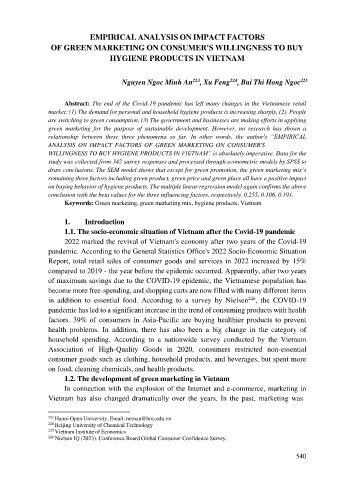Page 548 - Ebook HTKH 2024
P. 548
EMPIRICAL ANALYSIS ON IMPACT FACTORS
OF GREEN MARKETING ON CONSUMER'S WILLINGNESS TO BUY
HYGIENE PRODUCTS IN VIETNAM
223
225
Nguyen Ngoc Minh An , Xu Feng 224 , Bui Thi Hong Ngoc
Abstract: The end of the Covid-19 pandemic has left many changes in the Vietnamese retail
market: (1) The demand for personal and household hygiene products is increasing sharply, (2) People
are switching to green consumption, (3) The government and businesses are making efforts in applying
green marketing for the purpose of sustainable development. However, no research has shown a
relationship between these three phenomena so far. In other words, the author's “EMPIRICAL
ANALYSIS ON IMPACT FACTORS OF GREEN MARKETING ON CONSUMER'S
WILLINGNESS TO BUY HYGIENE PRODUCTS IN VIETNAM” is absolutely imperative. Data for the
study was collected from 342 survey responses and processed through econometric models by SPSS to
draw conclusions. The SEM model shows that except for green promotion, the green marketing mix’s
remaining three factors including green product, green price and green place all have a positive impact
on buying behavior of hygiene products. The multiple linear regression model again confirms the above
conclusion with the beta values for the three influencing factors, respectively, 0.255, 0.106, 0.191.
Keywords: Green marketing, green marketing mix, hygiene products, Vietnam
1. Introduction
1.1. The socio-economic situation of Vietnam after the Covid-19 pandemic
2022 marked the revival of Vietnam's economy after two years of the Covid-19
pandemic. According to the General Statistics Office's 2022 Socio-Economic Situation
Report, total retail sales of consumer goods and services in 2022 increased by 15%
compared to 2019 - the year before the epidemic occurred. Apparently, after two years
of maximum savings due to the COVID-19 epidemic, the Vietnamese population has
become more free-spending, and shopping carts are now filled with many different items
in addition to essential food. According to a survey by Nielsen 226 , the COVID-19
pandemic has led to a significant increase in the trend of consuming products with health
factors. 39% of consumers in Asia-Pacific are buying healthier products to prevent
health problems. In addition, there has also been a big change in the category of
household spending. According to a nationwide survey conducted by the Vietnam
Association of High-Quality Goods in 2020, consumers restricted non-essential
consumer goods such as clothing, household products, and beverages, but spent more
on food, cleaning chemicals, and health products.
1.2. The development of green marketing in Vietnam
In connection with the explosion of the Internet and e-commerce, marketing in
Vietnam has also changed dramatically over the years. In the past, marketing was
223 Hanoi Open University, Email: nnman@hou.edu.vn
224 Beijing University of Chemical Technology
225 Vietnam Institute of Economics
226 Nielsen IQ (2023). Conference Board Global Consumer Confidence Survey.
540

